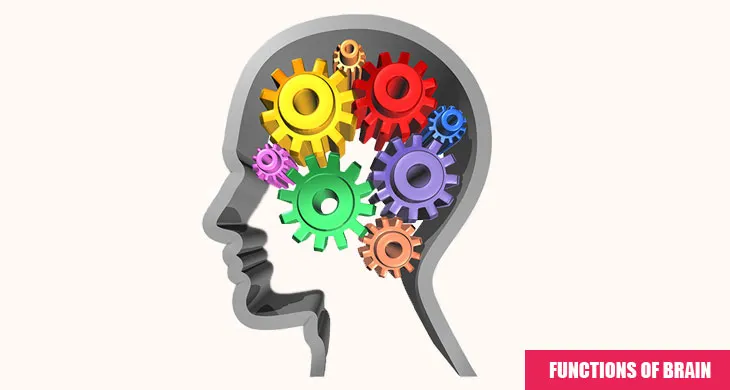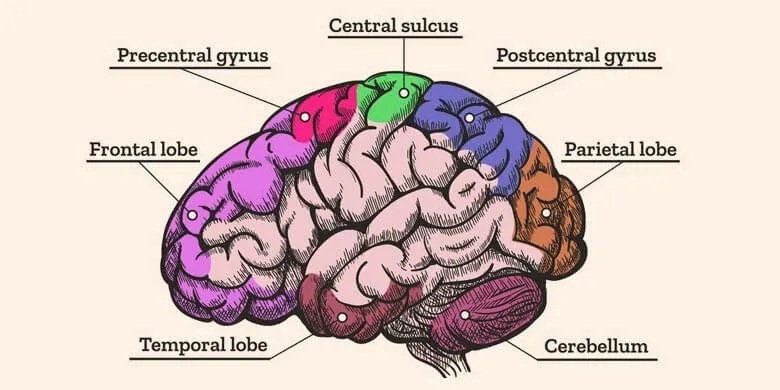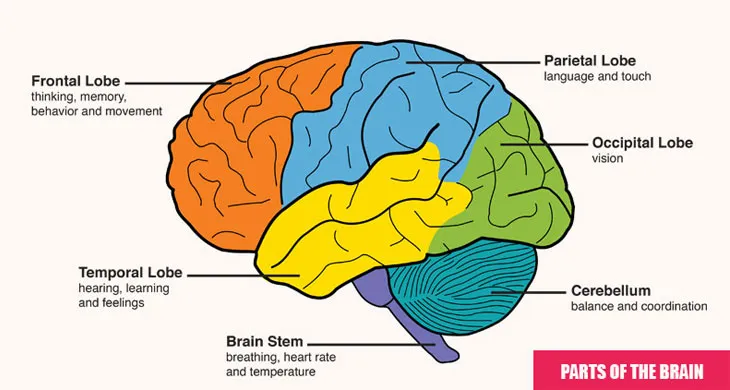What Are The Functions of Brain in Human Body?
Mark Wm. Dubin (2013) in his book How the Brain Works, calls the brain the single most complex machine ever constructed. It creates a unique experience you call humanness. The brain’s grey matter is composed of about 100 billion neurons and an even greater number of the supporting cells called the glial cells.

Functions of Human Brain
The neuron and the nerve cell are two alternative terms, denoting the basic structural and functional unit of the brain. Neurons form groups to execute functions of brain. However, a neuron is different from a nerve, which is the name for a bundle of axons, for example, an optic nerve.
In his Atlas of Brain Function, William W. Orison, Jr. (2008) delineates the functions of brain carried out by specific areas (functional sections) with the help of 3 Tesla MR Images technology.
Imaging an Active Brain:
The latest technology allows taking images of both the static and active brain states. With static imaging, the scientists can view the living brain and detect the structural changes in it. It fails to give information about the chemical or electrical brain activity.
On the other hand, the functional imaging technologies, such as fMRI (Functional Magnetic Resonance Imaging) allow the neuroscientists to view the active brain.
Splitting a Behaviour for Speedy Processing:
What enables the brain to speedily take in and respond to information? In addition to the division of labour, the brain splits a behaviour into its parts to speed up the process of taking in and responding to information. In this way, it also makes the most efficient use of its neurons.
Here you can consider taking the bite of food. It tasks your brain with processing many types of information, including sensory, voluntary motor, and involuntary motor.
Processing of sensory information allows you to identify if the given food is apple or something else. Voluntary motor information is used to lift the piece of food to the mouth and chew. The involutory motor information leads to salivation. After splitting, the pieces of information are sent to the appropriate brain regions for processing and triggering the required action.
Traditional and Non-Traditional Senses:
According to information provided in the NIH (National Institute of Health) Curriculum Supplement Series, the neuroscientists have discovered several kinds of sensations other than the traditional five senses. They include pain, temperature, pressure, movement, and the position of a joint in the body.
The sensory input is changed to electrochemical signals before it is transmitted to the brain for processing. These electrochemical signals are received in categories by specific regions of the brain, which separately decipher each message.
Changes in Brain Structure:
It was previously believed that the brain does not change after the first initial phase of neural development. But the new research has revealed that the brain canchange and reorganize itself in response to some input.
The change in the anatomy of neurons is termed as plasticity. Did you know the activity of learning is a form of plasticity as it brings structural changes in your brain? During learning, the neurons grow and strengthen themselves while forming new synaptic connections.
Functions of Brain and the Division of Labour:
There is a division of labour in the brain as different areas of the brain have been assigned specific tasks to perform. With the help of functional brain imaging, the researchers have discovered and distinguished between various functionally specialized regions of the brain.
If you divide the human brain into three major sections, the forebrain (cerebrum), hindbrain (cerebellum), and the brainstem, each division will have its own set of functions to perform.
And there is further subdivision in each major section. For example, one functionally specialized region to the front of the cerebrum is devoted to planning, solving problems, and making decisions. Other regions in the forebrain are used to interpret sensory information related to hearing, taste, and smell, etc.
Though various neuron groupings are devoted to a specific task, different areas in the brain do coordinate with each other to process certain information or regulate a function. For example, the regions of both the forebrain and hindbrain work together to regulate the functions like heartbeat and breathing.
The brain mass can be divided into different lobes, each acting as a functional section. The main functional sections include the frontal lobe, the parietal lobe, the occipital lobe, the temporal lobe, the cerebellum, and the brainstem.
Here is a list of the functions of brain in human body:
Knowing about the World We Live In:
It is the brain that enables us to know about and interact with the world around us. The sensory information collected by different sensory organs like the eyes, ears, nose, tongue, and the skin is processed by the brain to let us know what is going on in our environment.
Responding to Environmental Stimuli:
Did you know if your brain were able to process only the sensory input, you would be the motionless spectators of the world around you? It is due to the brain’s ability to process and give motor output – generate neural impulses –that we can respond to the environmental stimuli.
Some of these responses are voluntary, while others are involuntary. The voluntary responses include chewing a bite of food, lifting a piece of wood from the ground, and hitting at something, etc. On the other hand, heartbeat and breathing are some of the involuntary responses.
Attention and Concentration:
Attention is an individual’s ability to focus on important things and to ignore the rest. There are different types of attention like the spatial attention and the object-based attention. Attention and concentration are regulated in the frontal lobe of the brain.
The neuroscientists at MIT (Massachusetts Institute of Technology) came up with the findings that it is the inferior frontal junction (IFJ) – a part of the prefrontal cortex – involved in paying attention.
Self-monitoring and Organization:
Self-monitoring or self-regulation and organization are the function controlled by the frontal lobe of the brain.
Speaking, Motor Planning and Intuition:
The control centres for language (communication), motor planning, and intuition lie in the cerebral cortex (frontal lobe). According to Holland, the regions in the left part of the brain called the Broca’s area and Wernicke’s area are used for processing speech and language, respectively.
Touch and Spatial/Visual Perception:
The jobs like processing the sense of touching, visual perception, spatial perception, and differentiating size, shapes and colours are assigned to and accomplished by the parietal lobe of the cerebral cortex.
Judgement and Problem-solving:
Judgment and problem-solving are the advanced brain functions which are highly developed in humans. They are regulated by the frontal lobe.
Vision:
Located to the back of the brain, it is the occipital lobe which serves as the control centre for vision. It enables you to see things around.
Emotions and Impulse Control:
Emotions are natural to humans. These are used to react to different situations. The controls for emotions and impulse lie in the frontal lobe of the cerebral cortex.
Personality Traits:
Your unique personality traits (behaviours, conditions, and emotions) are regulated by the frontal lobe of the cerebrum.
Memory and Learning:
While many scientists believe that all the brain parts are involved with memory, there are some who argue that memory is created and stored in specific parts of the brain. The frontal cortex, the cerebellum, the hippocampus, and the amygdala are the main parts of the brain involved with memory. The cerebral cortex also assists inthe processes of thinking and learning.
Eye Movement:
The eye movement is controlled by the midbrain, which forms one of the three major parts of the brainstem, the others being medulla oblongata and pons. The midbrain also processes auditory and visual information.
Balance and Coordination:
Did you ever notice people after consuming narcotics lose their balance and start staggering? It is because such drugs affect the centres for balance and coordination, which lie in the cerebrum lobe of the brain.
Breathing and Heartrate:
The functions of the lungs and heart – breathing and heartrate – are regulated by medulla oblongata. The lowest part of the brain, the medulla oblongata also controls the functions like wheezing sneezing and swallowing.
Sleep and Consciousness:
Acting as a relay station for the signals or sensory input coming into the brain, the thalamus also plays its role in regulating sleep and consciousness.
Body Homeostasis:
Homeostasis refers to the maintenance of the constant internal environment against changes in the surroundings. The hypothalamus helps to maintain homeostasis by regulating temperature, controlling the production and release of hormones, and maintaining daily physiological cycles like the sleep-wake cycle.
Interesting Questions About The Function of Brain You Want to Know!!
- Is there a division of labour in the brain?
- How does learning change brain structure?
- What enables the brain to speedily take in and respond to information?
- Malfunctioning in which part of the brain affects your ability to make decisions?
- Which regions in the brain are responsible for regulating breathing and heartbeat?
- What are the kinds of sensations other than five senses?
More About Brain:

What is Brain
Read More...
Function of Brain
Read More...
Brain Disorders
Read More...


